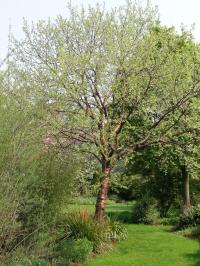Trees Selection and Planting
 Prunus serrula, or more commonly known as the Tibetan Cherry
Prunus serrula, or more commonly known as the Tibetan CherryPossibly the most important choice of planting and positioning that any gardener can face is the gift to the next generation; trees.
Since I noted carefully the sun's changing position through the seasons and had already decided on the layout of my garden before I came to select my trees, I was in a good position to choose the rights ones and to put them in the right place. Let's look at these two issues separately.
Choice of Trees
Firstly then, which trees? Well, I think the most important thing here is to choose trees that you like. After all, you are going to have to live with them for a while, and they may end up being the most expensive plants you buy. To help in your selection, it is best to choose from trees you have seen in their fully grown state, and not just in pictures. I was quite lucky here as Pauper and Guru's folks not only have a range of ornamental and fruit trees growing in their own garden, but also because they very generously introduced Mrs Pauper and I to Barnsdale Gardens in Rutland. Established by Geoff Hamilton way back when, this is not only a fantastic source of ideas for garden layout in general, but also contained a prime example of one of the trees I chose for my own plot. By visiting on several occasions, I got to know and love the varying hues and expected size of the bronze barked Tibetan Cherry (Prunus serrula).
My next selection was a Gleditisia tricanthos 'Sunburst', AKA Japanese Honey Locust, which makes me tingle with its stunning layered foliage, bright colour in spring and the dappled shade it provides.
Despite the small size of my garden, I was determined to add a couple more. Loving anything free of charge (well, almost anything; I'd turn down a dicky tummy or the Bends), I choose a Charles Ross Apple Tree (ideal for eating or cooking) and a Purple Plum to provide a little tang.
I ordered these in June last year, had them delivered in their dormant state in November and that is when I got down to planting.
Choosing the Position
Knowing the size and shape of a full grown tree is very important in deciding where to put it, especially if financial freedom is still a distant dream and therefore you have a tiny plot and only the bare root, branchless versions of your choices. For me, the aim was simple; create privacy from the houses overlooking us from all angles without blocking out sunlight that floods into my windows and without undermining the foundations of my house.
The most important thing to do is to take your time. Pace the garden, thinking about the direction that sunlight falls, when and where the shade of the tree will be and where the buildings are that you wish to block from view. Also consider where the tree trunks will stand in relation to the garden layout. As I found by using sticks as a mock up, an inch to the left or right, to front or rear can make a huge difference to the overall effect. Even the rotational aspect of the trees, bearing in mind its current branches, needs to be done with Feng Shui like precision to avoid later regrets. It took me four hours of pacing and visualising to get it right. A year later, I'm glad I took my time.
But at this point, I have a confession to make. I recently realised that my Purple Plum, positioned away from the house and patio to distance the inevitable swarm of wasps that dine on the fruits, was actually way too close to the place where I spend the most time in my garden, my home made Gazebo! You win some, you loose some I guess.
This article was written by Joe Munford.
Filed under Garden Design.
